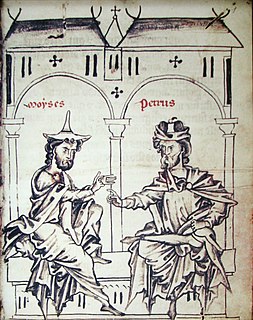Related Research Articles

The House of Commons is the lower house and de facto primary chamber of the Parliament of the United Kingdom. Like the upper house, the House of Lords, it meets in the Palace of Westminster.

The Parliament of the United Kingdom is the supreme legislative body of the United Kingdom, the Crown dependencies and the British overseas territories. It alone possesses legislative supremacy and thereby ultimate power over all other political bodies in the UK and the overseas territories. Parliament is bicameral but has three parts, consisting of the sovereign (Crown-in-Parliament), the House of Lords, and the House of Commons. Parliament is also tasked with enforcing the laws that it passes. The political party or party coalition that controls the majority of seats in the Commons chooses the national executive for the country, the prime minister of the United Kingdom. The prime minister and their cabinet wield the executive powers for the entire country but must possess the confidence of Parliament to remain in office. Because of this it is not unusual for Parliament to hold elections more frequently than the required five years. Both houses of Parliament meet in separate chambers at the Palace of Westminster in the City of Westminster, one of the inner boroughs of the capital city, London.

Cloture, closure or, informally, a guillotine, is a motion or process in parliamentary procedure aimed at bringing debate to a quick end. The cloture procedure originated in the French National Assembly, from which the name is taken. Clôture is French for "the act of terminating something". It was introduced into the Parliament of the United Kingdom by William Ewart Gladstone to overcome the obstructionism of the Irish Parliamentary Party and was made permanent in 1887. It was subsequently adopted by the United States Senate and other legislatures. The name cloture remains in the United States; in Commonwealth countries it is usually closure or, informally, guillotine; in the United Kingdom closure and guillotine are distinct motions.

Parliamentary procedure is the body of ethics, rules, and customs governing meetings and other operations of clubs, organizations, legislative bodies, and other deliberative assemblies.

A committee or commission is a body of one or more persons that is subordinate to a deliberative assembly. Usually, the assembly sends matters into a committee as a way to explore them more fully than would be possible if the assembly itself were considering them. Committees may have different functions and their types of work differ depending on the type of the organization and its needs.
A motion of no confidence, vote of no confidence, or no confidence motion, sometimes in the reverse as a motion of confidence or vote of confidence, is a statement or vote about whether a person in a position of responsibility is still deemed fit to hold that position, perhaps because they are inadequate in some aspect, are failing to carry out obligations, or are making decisions that other members feel as being detrimental. As a parliamentary motion, it demonstrates to the head of state that the elected parliament has or no longer has confidence in the appointed government. In some countries, if a no confidence motion is passed against an individual minister, the minister then must resign. In most cases, if the minister in question is the premier, then all other ministers must also resign.

The Lok Sabha, or House of the People, is the lower house of India's bicameral Parliament, with the upper house being the Rajya Sabha. Members of the Lok Sabha are elected by an adult universal suffrage and a first-past-the-post system to represent their respective constituencies, and they hold their seats for five years or until the body is dissolved by the President on the advice of the council of ministers. The house meets in the Lok Sabha Chambers of the Sansad Bhavan, New Delhi.

Debate is a process that involves formal discussion on a particular topic. In a debate, opposing arguments are put forward to argue for opposing viewpoints. Debate occurs in public meetings, academic institutions, and legislative assemblies. It is a formal type of discussion, often with a moderator and an audience, in addition to the debate participants.
In parliamentary procedure, a division of the assembly, division of the house, or simply division is a method of taking a vote that physically counts members voting.
Congressional Debate is a competitive interscholastic high school debate event in the United States. The National Speech and Debate Association (NSDA), National Catholic Forensic League (NCFL) and many state associations and national invitational tournaments offer Congressional Debate as an event. Each organization and tournament offers its own rules, although the National Forensic League has championed standardization since 2007, when it began to ask its districts to use one of a number of procedures for qualification to its National Tournament. The Pakistan Student Congress event is a conference, and not interscholastic competition.
In deliberative bodies a second to a proposed motion is an indication that there is at least one person besides the mover that is interested in seeing the motion come before the meeting. It does not necessarily indicate that the seconder favors the motion.
Markup is the process by which a U.S. congressional committee or state legislative session debates, amends, and rewrites proposed legislation.
In parliamentary procedure, unanimous consent, also known as general consent, or in the case of the parliaments under the Westminster system, leave of the house, is a situation in which no member present objects to a proposal.
In parliamentary procedure, the previous question is generally used as a motion to end debate on a pending proposal and bring it to an immediate vote. The meaning of this specialized motion has nothing to do with any question previously considered by the assembly.
A committee of the whole is a meeting of a legislative or deliberative assembly using procedural rules that are based on those of a committee, except that in this case the committee includes all members of the assembly. As with other (standing) committees, the activities of a committee of the whole are limited to considering and making recommendations on matters that the assembly has referred to it; it cannot take up other matters or vote directly on the assembly's business. The purpose of a committee of the whole is to relax the usual limits on debate, allowing a more open exchange of views without the urgency of a final vote. Debates in a committee of the whole may be recorded but are often excluded from the assembly's minutes. After debating, the committee submits its conclusions to the assembly and business continues according to the normal rules.
Deliberative assemblies – bodies that use parliamentary procedure to arrive at decisions – use several methods of voting on motions. The regular methods of voting in such bodies are a voice vote, a rising vote, and a show of hands. Additional forms of voting include a recorded vote and balloting.
In parliamentary procedure, a motion is a formal proposal by a member of a deliberative assembly that the assembly take certain action. Such motions, and the form they take, are specified by the deliberate assembly and/or a pre-agreed volume detailing parliamentary procedure, such as Robert's Rules of Order, Newly Revised; The Standard Code of Parliamentary Procedure; or Lord Critine's The ABC of Chairmanship. Motions are used in conducting business in almost all legislative bodies worldwide, and are used in meetings of many church vestries, corporate boards, and fraternal organizations.
Debate in parliamentary procedure refers to discussion on the merits of a pending question; that is, whether it should or should not be agreed to. It is also commonly referred to as "discussion".
In parliamentary procedure, using Robert's Rules of Order Newly Revised (RONR), the motion to consider by paragraph is used to consider separately the different parts of a report or long motion consisting of a series of resolutions, paragraphs, articles, or sections that are not totally separate questions.

Erskine May is a parliamentary authority originally written by British constitutional theorist and Clerk of the House of Commons, Thomas Erskine May.
References
- ↑ Petyt, George. Lex Parliamentaria. p. 169.
- ↑ Robert, Henry M.; et al. (2011). Robert's Rules of Order Newly Revised (11th ed.). Philadelphia, PA: Da Capo Press. p. 270. ISBN 978-0-306-82020-5.
- ↑ Robert 2011 , pp. 275–276
- ↑ Robert 2011 , pp. 274–275
- ↑ May, Erskine (1989). Erskine May: Parliamentary Practice (21st ed.). Butterworths. pp. 335–6. ISBN 0-406-11471-4.
- ↑ Rules of Procedure of the European Parliament (WebCite Archive)
- ↑ Robert 2011 , p. 278
- ↑ Robert 2011 , p. 280